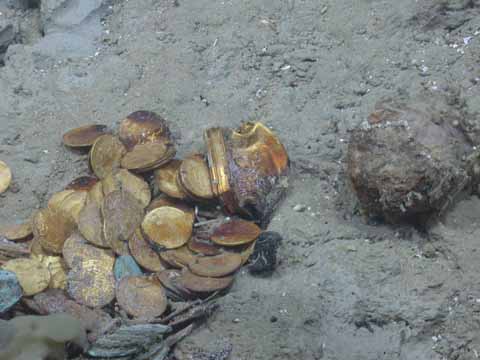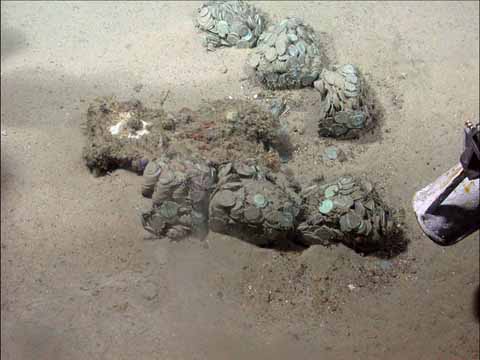 Over the years, Odyssey Marine Exploration has discovered hundreds of shipwrecks at the bottom of the vast oceans. Using state of the art technology, researchers and scientists, the company has recovered vast amounts of treasure and artifacts spanning the thousands of years that mariners have sailed the oceans.
Over the years, Odyssey Marine Exploration has discovered hundreds of shipwrecks at the bottom of the vast oceans. Using state of the art technology, researchers and scientists, the company has recovered vast amounts of treasure and artifacts spanning the thousands of years that mariners have sailed the oceans.
Some of Odyssey’s more recent discoveries include:
- The SS Republic, a Civil War era shipwreck from which over 51,000 coins and 14,000 historically significant artifacts were recovered. The wreck was discovered in 2003 at 1,700 feet below the surface.
- The discovery of the HMS Victory in 2008 was described by Odyssey as “one of the most significant shipwrecks in history. The HMS Victory, the flagship of Admiral Sir John Balchin, went down in 1744.
- In 2011, Odyssey fascinated the world with the discovery of two ships that were sunk by enemy fire during the World Wars. The SS Mantola, a British steamer, torpedoed and sunk by a German submarine on February 8, 1917, is believed to have 600,000 ounces of silver on board. The SS Gairsoppa, a British cargo ship, was sunk by a German submarine on February 17, 1941 and lies 4,700 meters below the surface. The SS Gairsoppa is believed to hold about 7,000,000 ounces of silver. Recovery on both wrecks is scheduled to begin this year. Under agreements with the UK Government, Odyssey will retain 80% of the cargo salvaged from the two wrecks.
In May 2007, Odyssey announced the “Black Swan” discovery of a Colonial era shipwreck located off the coast of Portugal. Odyssey recovered more than 500,000 silver coins that were scattered about on the ocean bottom. The treasure hoard weighed more than 17 tons which equates to about 545,000 ounces of silver. In addition to the silver coins, Odyssey also recovered hundreds of gold coins and worked gold from the wreck site.
Based on the facts presented in Odyssey’s website, it seemed clear that the treasure belonged to Odyssey. Little did Odyssey realize that the U.S. Government was working behind the scenes to overturn established law and strip Odyssey of its rights to the Black Swan treasure.
After Odyssey announced the find, the Kingdom of Spain laid claim to the sunken treasure, contending that the wreck was a Spanish sovereign ship and therefore the property of Spain. Since the shipwreck was clearly in international waters, Odyssey was confident that any claims against its find would not be upheld by the courts.
Spain claimed that the sunken ship was the Nuestra Señora de las Mercedes, a Spanish merchant ship that was sunk by the British in 1804. Odyssey maintained that there was no hull or other evidence available at the site to positively identify the ship and, in addition, a number of other ships had gone down in the area.
Odyssey noted that even if the ship could be positively identified as the Nuestra Senora, as a commercial vessel, Spain would have no valid claim to the salvaged treasure. International law prohibits treasure seekers from claiming salvage rights only to sunken warships and not commercial vessels. Odyssey also said that Peru, from whom the treasure had been plundered, was also seeking to assert its rights to the silver treasure.
Last week, Odyssey was shocked when the a Federal judge sided with Spain and ordered Odyssey to surrender the gold and silver treasure to Spain. Odyssey, which held the gold and silver in its custody pending court ruling, said it spent $2.6 million on recovery, transportation and conserving the treasure. It was not immediately clear if Odyssey would be compensated for its costs. The value of the recovered treasure has been estimated to be as high as $500 million.
Odyssey was clearly stunned by the court ruling and the lack of a coherent explanation by the Federal judge as to why Spain prevailed in its case against Odyssey. Spain, which is tottering on the edge of sovereign default, desperately needs the money that the sale of the Black Swan treasure would bring. Was there some behind the scenes manipulation by the U.S. Government to help Spain?
Based on secret information disclosed by WikiLeaks, Odyssey believes that the court ruling went against them due to “surreptitious negotiations” between the U.S. and Spain and that the court’s decision was “contrary to established law”. Odyssey went to their Congresswoman for help who wrote the following letter to Hillary Clinton, Secretary of State.
Congresswoman Castor raises serious questions about the troubling role of the U.S. Government in manipulating the outcome of Spain’s claim against Odyssey. Property rights and the rule of law seem to have been trashed by the Government based on some ulterior motive to award the Black Swan treasure to Spain. The most chilling aspect of this case for holders of precious metals or wealth of any type is that government expropriation of property can be arbitrarily exercised and there is nothing you can do about it.



